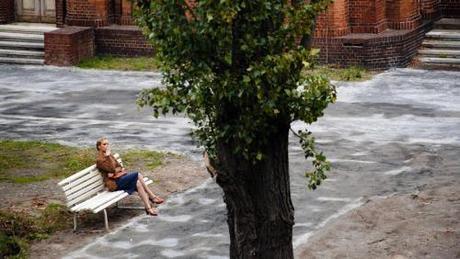
Christian Petzold must aspire to make all sorts of strange movies. He has assembled an arsenal of techniques, and a not-quite-formalist grammar, both original enough to be impressive.
You can go off the fantastic Notebook interview (here), but the proof is in the pudding. Barbara looks and frequently behaves like a great movie, but admits frankly that it is not. Especially in its ending, which forces us to accept what we could scarcely believe through the rest of the ride: this is, more or less, a standard mystery/thriller told in a more sophisticated, deliberately articulate way than you might expect. It’s no The Conformist, but it’s a hell of a lot more to chew on than The American. Anyway, the film does stick with you.
What Petzold calls “spatial suspense” is no joke. He’s playing a very tight game. I’m just not convinced that the ends have here justified the means. The means in this case being not merely visual, but apparently a more-than-a-little eccentric production process, and the ends being narrative.
When Petzold says in the interview (neither bragging, nor confessing) that he deals primarily in first takes, anyone who has seen Barbara will scarcely be surprised. It’s a great explanation for the constant discomfort, and the constant, organic tension we perceive burning out of the center and the soul of our heroine. She is walking a tightrope. The anxiety performed, and the anxiety in regards to the performed, have theoretically coalesced into something altogether more potent.
And all right, I’ll drop the “theoretical” qualifier. It is something altogether more potent, in terms of character and performance.
Yet the film leaves us troublingly little to talk about when it’s over. The aesthetics of ambiguity are nearly all show. And the character of Barbara herself as a cypher, as a mystery in her own right, I don’t really buy. The most interesting bits of that are in the first series of shots, when she is only being looked at, and is not yet performing those weighty duties we impose on every protagonist. In the end, the film represents a straightforwardness that I don’t resent, but also don’t much enjoy.
What Ignatiy Vishnevetsky has identified as “suspense by induction rather than coercion” may or may not be the most compelling way to handle suspense. I welcome the absence of didacticism, the favor given to texture and objects-in-the-world over blunt, violent plotting, but I think the narrative has got to match. What’s the point of telling the same story with higher, subtler language, unless that language can manage to reveal what we never saw before?
But maybe that’s an old question.
-Max Berwald
